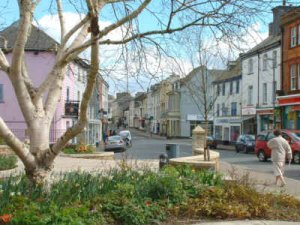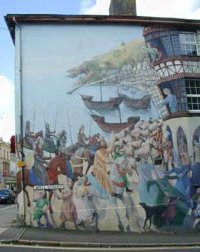


Historical market town famous for its pastys
Callington is a small ancient market town situated in the beautiful area of south east Cornwall, at the head of the Tamar Valley. It lies six miles from the River Tamar, which forms the boundary between the counties of Devon and Cornwall, this area is now classified as an Area of Outstanding Natural Beauty. The market town of Launceston lies nine miles to the north, Liskeard is nine miles to the west and Tavistock in Devon is to the east, with Saltash seven miles to the south. The city of Plymouth, also in Devon is 14 miles to the south-east. The town sits on the crossroads of the A388 and the A390. The population of the town was 5,665 at the 2011 census.
The Battle of Hingston Down took place in 838, at Hingston Down just east of the town, between a combined force of Cornish and Vikings on the one side, and West Saxons led by Ecgberht, King of Wessex on the other. The result was a West Saxon victory
Originally a Saxon settlement and probably called Celliwic, the town had a population of 200 at the Norman conquest. Callington (Calweton, Calvington, Killington, Killiton) is mentioned in the Domesday Book of 1086 as Calwetone. In 1229 Callington was granted a Royal Charter for a Honey Fair. One of the only such fairs in England. In 1584, Callington became a Parliamentary Borough, and continued to send two members to Parliament, until "rotten boroughs" were abolished under the Reform Act of 1832.
Although Callington's history goes back many centuries, the 19th century had a significant effect on the town and it's development due to the mining boom in the adjacent areas. Miners from the Callington area emigrated to many parts of the world when the mining boom collapsed. The industrial heritage from this era still remains as part of the landscape. Today its main employment opportunities are connected to farming and tourism and the development of small businesses. Probably the largest employer in the town is the Ginsters factory which manufactures, among other foods, Cornish pasties which are widely distributed around the UK.
It is within easy reach of the beautiful Tamar Valley and the Area of Outstanding Natural Beauty extends to the edges of the parish. The south east corner of Bodmin Moor is within easy reach and the town itself is dominated by the 1000 foot high Kit Hill, a natural feature that has played a significant part in the history of the town. Prince Charles, the Duke of Cornwall, gave the Kit Hill to the county in 1985 and it is now a country park.
The 15th century St. Mary's church is at the centre of the town. It is worth a visit to view the Celtic lantern cross in the churchyard and the ancient tombs of the Ayssheton and Willoughby families. Nearby is the Old Clink, originally a parish vestry room and two small rooms where the constable would detain petty criminals awaiting the visiting magistrate. Opposite the church a lane leads to the Pannier Market.

Fore Street is the main shopping street and the aptly named Well Street is where the town's original water supply flowed from the pipe well. The water still flows, although the town has long supplied by the local water authority.
Half a mile from the town centre, off the Saltash Road, is Dupath Well a tiny oratory well. There a spring rises under a chapel built by monks in the 15th century. The water in the basin was believed to cure whooping cough. More of Callington's history can be found to the west. At Newbridge the A390 crosses the River Lynher and woodland walks follow the river. Climb then to Cadson Bury, an Iron Age enclosure, again offering fine views over the Cornish farmlands.
The town has a well known mural trail with over twenty murals, many depicting the town's past as well as the future. The murals have been painted by local artists as well as college students and school children.
Kelly Bray which us only about a mile north of Callington, was once connected by a branch railway line from Gunnislake, but it was closed in 1966. The Callington Mining Company which employed a workforce of over 250 people around Kelly Bray continued until 1946.
Selina Cooper (1864-1946), Suffragette and the first woman to represent the Independent Labour Party was born in Callington.
Leonard Austen Harvey (1907–1976), He was born in Stoke Climsland, near Callington. A great defensive boxer, he boxed at every weight division available at the time, from flyweight to heavyweight. He became the light-heavyweight and heavyweight champion of the British Empire, and was recognised as world light-heavyweight champion in Britain from 1939 to 1942.
The Foot family of politicians lived at Pencrebar just west of the town. Isaac Foot (1880-1960) died at the house and Michael Foot (1913-2010) and Sir Dingle Foot (1905-1978) have also lived at the property. John Mackintosh Foot, Baron Foot (1909–1999) was a Liberal politician and Life Peer.
Callington Vintage Rally - Beginning of May.
Callington Mayfest - Mid May.
On the first Wednesday in October each year, the Honey Fair brings to the town street traders, entertainers and exhibitors from far afield. Thousands of people flock to the unique annual event.
Bodmin Moor Callington Heritage Centre Gunnislake Minions The Tamar Valley
Ken-Caro Gardens Kit Hill Country Park Liskeard Cotehele House Saltash